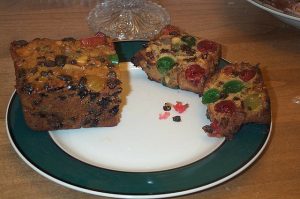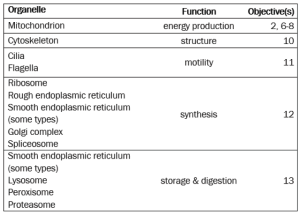Cytoplasm, Cytosol, and Organelles
Objective 5.1
5.1.1 Describe and contrast cytoplasm, cytosol, and organelles.
 Not everyone likes fruitcake, but everyone has a fruitcake-like arrangement of structures inside every body cell. Like a fruitcake contains cake interspersed with pieces of candied fruit, the cytoplasm of the cell contains a liquid (cytosol, like the cake) interspersed with large, semi-independent structures (organelles, like the candied fruit pieces). In other words, just as cake + fruit = fruitcake, cytosol + organelles = cytoplasm.
Not everyone likes fruitcake, but everyone has a fruitcake-like arrangement of structures inside every body cell. Like a fruitcake contains cake interspersed with pieces of candied fruit, the cytoplasm of the cell contains a liquid (cytosol, like the cake) interspersed with large, semi-independent structures (organelles, like the candied fruit pieces). In other words, just as cake + fruit = fruitcake, cytosol + organelles = cytoplasm.
Cytosol is primarily water (solvent) and contains dissolved solutes, suspended particles, lipid droplets, and glycogen granules. Solutes found in the cytosol include K+, Na+, Cl–, HCO 3–, PO3–, other ions, sugar monomers and polymers, amino acid monomers and polymers, and RNA. Some of these solutes are made other places and then moved into the cytosol (for example, we’ll see in Unit 6 that RNA is made in the nucleus and moved into the cytosol for protein synthesis).
Since almost everything we discussed in Units 2 and 3 is found in the cytosol, take time to review those units as needed. (DNA is the exception; it’s found only in the nucleus and in mitochondria, not in the cytosol.)
The business of the cell is carried out by the organelles (Latin organum “instrument” and -elle “little”). As the name implies, these are like little organs performing needed functions inside cells, just like our organs perform needed functions inside our bodies.
We can divide the organelles into five groups based on their function:
- energy production
- structure
- motility
- synthesis
- storage & digestion

We will begin at the top of the list and discuss mitochondria, the energy production organelle, first.
Media Attributions
- Traditional_fruitcake © Stu Spivack is licensed under a CC BY-SA (Attribution ShareAlike) license
- U05-002 table of organelles with objectives © Hutchins, Jim is licensed under a Public Domain license

